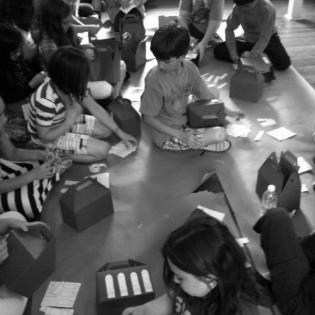Meal Math (Private-Religious)
This lesson will raise awareness of what constitutes a nutritious meal as well as the price of a healthy meal. Students will learn that some people lack the funds to pay for nutritious meals. It will also motivate the students to raise money to pay for meals
The learner will:
- estimate and research the cost of a nutritious meal.
- demonstrate a sense of what constitutes a nutritious meal.
- add the price of four food items.
- present his/her menu orally to the class.
- communicate (orally or in writing) the importance of giving tzedakah.
- help raise money to pay for a meal.
- Poster or student copies of the food pyramid/food groups
- Teacher-made list of basic food items with prices (Use pictures, words, and rounded prices e.g. whole chicken for $7, bag of carrots for $2 (Organize the list by food groups)
- Student copies of Attachment One: Cost of a Meal (in Spanish, Handout Two)
- Calculators, optional
Student will take a tzedakah box home for their family. When family members have spare change they will put it in the tzedakah box.
- Talmud Bava Batra 10a
Instructions
Anticipatory Set:Ask the students if they had a nutritious breakfast (or lunch) today.Listen to their responses to determine their understanding of nutrition.Say, “I had a candy bar and some chips for lunch.Was that a nutritious lunch?Why not?”Discuss with the students what constitutes a nutritious meal e.g. protein, vegetable, carbohydrate.Display a food pyramid and discuss healthy choices.
Ask the students whether they think eating a nutritious meal is expensive.Ask them whether they think cooking and eating a nutritious meal might be difficult for some families to afford.Tell them that they will do some research and use some math to estimate the cost of some nutritious meals.Then they will be able to estimate how many meals they can buy for some families in need of nutritious food.
Arrange the class into small groups.Give the teacher-made list of grocery items to each group.Give each child a copy of Attachment One: Cost of a Meal.
It is the responsibility of each student to plan a menu for one well-balanced meal, choosing foods from four food groups on the list.(Students choose one protein, one vegetable or fruit, one carbohydrate, and one milk-group item.) They may discuss the choices within their group, but each student should write a menu.
On the worksheet, students write the names of the foods they chose from the grocery list and their prices.Tell students to keep in mind they are making a meal for a family.
Tell the students to add the prices to get a total for the meal. Help younger students, as needed. Discuss and compare the costs of some of the meals.Which meal was least expensive?Most expensive? Line up the totals and find the middle cost.Make sure your students understand that these are only estimates.
Calculate the average of the costs of the meals.Write the amount on the board.Tell the students that each day tzedakah will be collected, with the goal to collect that amount – to pay for a meal.If a few classes work simultaneously on this lesson, their tzedakah money can be combined, and the goal reached more quickly.
Write this quote on the board: “If a person gives even a pruta (the least valuable coin) to the poor, he merits and receives the presence of God.” (Talmud Bava Batra 10a) Discuss what this pasuk means.Talk about the importance of giving even one penny to tzedakah.
Students will be assessed based on: their menu presentation to the class math skills demonstrated understanding of giving charity.
Students collect tzedakah to pay for a meal.
Handouts
Philanthropy Framework
-
Strand PHIL.IV Volunteering and Service
-
Standard VS 01. Needs Assessment
-
Benchmark E.2 Research the need in the school, neighborhood, local community, state, nation, or world.
-
-
Standard VS 02. Service and Learning
-
Benchmark E.2 Identify specific learning objectives from the academic core curriculum that are being applied in the service-learning project.
-
-
Standard VS 03. Providing Service
-
Benchmark E.1 Provide a needed service.
-
-
Standard VS 04. Raising Private Resources
-
Benchmark E.4 Set a fund-raising goal and identify sources of private funds.
-
-
